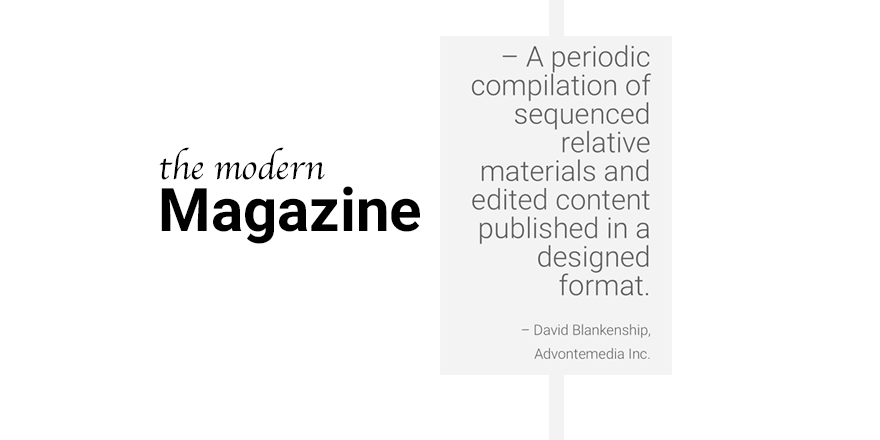
Modern Magazine Media Format Definitions
What is a magazine? The greatest aspect relative to the use of the word magazine as part of a published brand name is that the publisher’s potential audience already understands the basic brand offering based on the connotation of the word magazine. Consumers immediately visualize the historic traditional or even modern digital edition paginated format of a publication when the word “magazine” is used to identify the media brand. For publishers that operate with the goal of providing quality, relevant, niche encompassing content to their defined audience, the magazine element of the brand remains the iconic periodic content based deliverable and the magazine website is the key access point and hub of the brand. I present this magazine terms primer as a tool for understanding and developing modern magazine media definition terms, specifically print, digital, digital edition, and app based magazine formats.
The publication website contains access to periodic, live, resource, and interactive content. The website is a critical ongoing destination for key audience participants and the portal for magazine marketing promotions, advertising revenue, and new audience growth processes. Traditional publisher brand extensions such as events, guides, and directories can be promoted within the modern publication website as well as new media publishing elements. Email newsletters and social posts are the beacon tools that bring the magazine brand current audience back to the website on an ongoing basis to view new content as well as community collaboration, comment discussion, social media sharing, plus advertising and other revenue generating publisher functions. For the anchor periodic deliverable of the magazine publishing business mode ‘The Magazine’ it’s format and delivery based on print and digital formats has evolved into several key magazine phrase definitions.
The following definitions of modern magazine media are a work in progress and I welcome collaboration and enhancements for necessary ongoing revisions. I base my definitions my own observed cultural and technical usage perspective and not as a derivative of either traditional institutional or educational reference of related media industry terms.
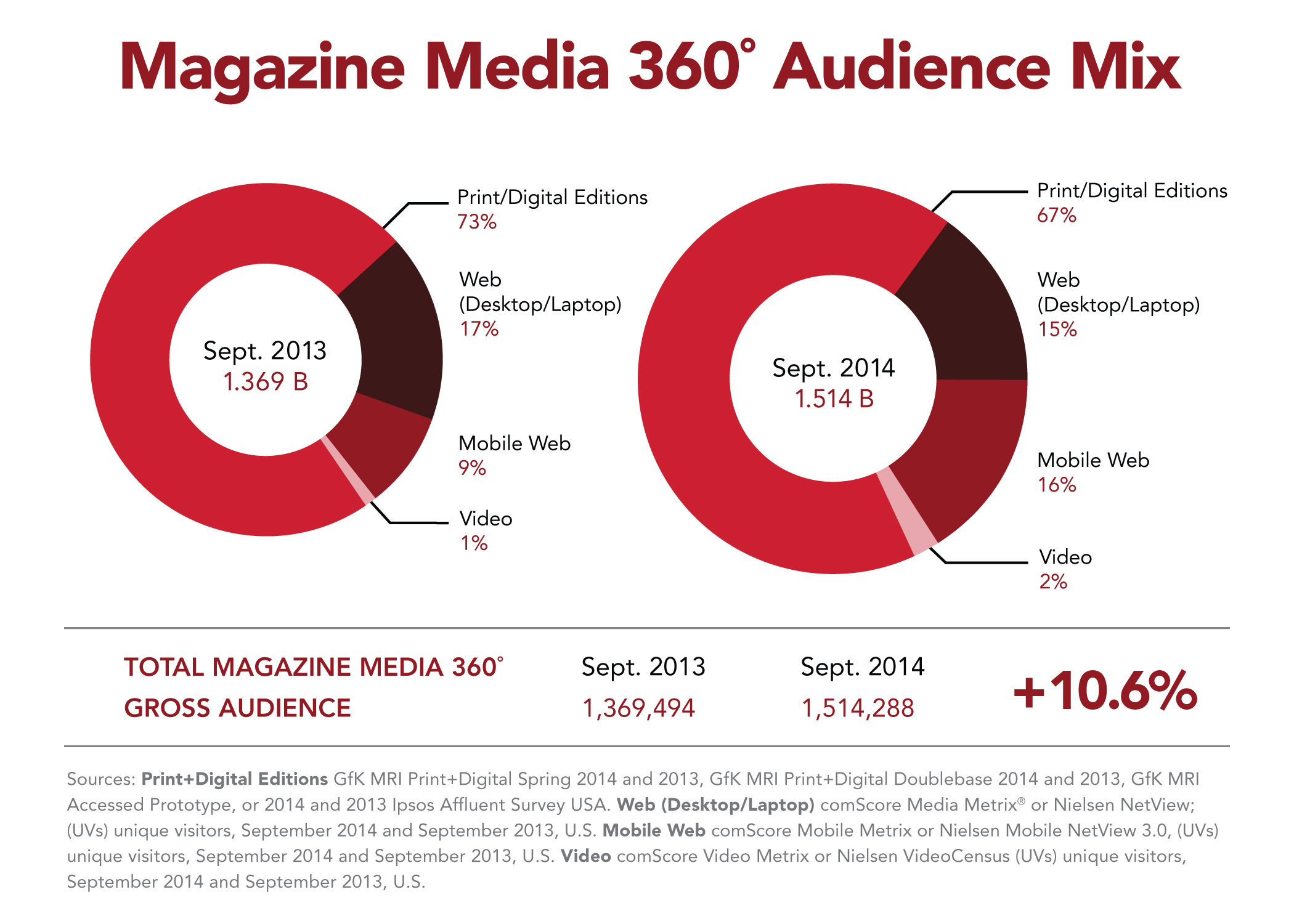
While I have always respected the printed magazine business model, I favor modern technology, new media, and digital innovation as a requirement for the prosperous future of the magazine publishing industry. I am admittedly biased toward a digital publishing future and I see many opportunities for digital publishing advancement for existing and new publishers. I believe the magazine business model will survive and thrive digitally. And according to The Association of Magazine Media (MPA) overall magazine media is indeed on the rise.
This significant growth is largely attributable to a 90% rise in mobile web use, a doubling of video consumption and the steady performance of print/digital editions, which were up 2.1%. – MPA website source
The current generation of journalism students and graduates understand the tools and modern digital publishing mediums and will help to pull their traditional print focused publishing organization employers forward. And if their modern media ideas and recommendations are met with resistance they will leave the traditional publishing business and forge ahead independently with nimble new innovative media brands.
Print Magazine Definition

PRINT MAGAZINE
– A page layout designed sequence of brand topic related and edited content elements printed and bound as a completed periodic edition.
Print magazine distribution occurs via mail based on paid or controlled opt-in subscription, physical newsstands in bookstores and retail settings, or distributed via pick-up locations, special events, direct marketing, membership, or made available as a value added resource for consumers as part of a service experience. Print magazines may also have a higher than 1:1 readership rate based on pass along readership of the physical magazine via person-to-person sharing and leave-behind placement. Circulation of these publications has typically been audited by third party organizations such as Audit Bureau of Circulation (ABC) or BPA Worldwide to provide credibility for fulfillment and readership to advertisers.
Digital Magazine Definition
DIGITAL MAGAZINE
– A designed sequence of brand topic related and edited content elements published digitally in a logical linear navigation view or flow based UX including issue contents or visual navigation, capable of user interaction and social media sharing.
Digital magazines are accessed via the Internet (online) by authenticated (registered / logged in) or public audience visitors and viewed using prevalent media screen resolution ranges for desktop and mobile devices. The digital magazine typically utilizes multimedia or interactive elements that accent the medium’s ability to leverage its content in the digital format. Common additional metaphors for this magazine media format include interactive magazine, online magazine, e-magazine, and web magazine.
ABC requires that digital magazine replicas (assumes digital is a print derivative) include the print edition’s full editorial content and advertising, but does not require layout to be identical to the print magazine edition. Audit bureau organizations now also audit digital circulation and overall magazine website audience traffic data. Audit organizations monitor both the execution of the digital delivery notice as well as the actual digital edition readership. Digital magazine platform analytics allow for detailed metrics beyond the pages viewed, time spent, and reader interactions, however the unique issue visits and pageviews is typically the result focus similar to website stats reporting.
Digital magazines may present in the traditional print-like and digital edition horizontal page-flip reading format to accomplish a linear page-by-page user interface. However, new and innovative UX web-based organization and scrolling user interface structures that maintain a sequential editorial composition and leverage a responsive content presentation will eventually be preferred to these fixed page (page flip) layout structure interfaces.
Digital Editions
DIGITAL EDITION – A digital magazine version based on a paginated magazine layout edition presented digitally in a linear page simulated user interface with basic issue content navigation and utility tools based on the reader access application.
The usage of “digital edition” by a publisher implies a multi-channel publishing model where additional delivery formats or editions versions, typically print would also be available for the magazine issue. The digital edition (digital magazine edition) is part of the broader “digital magazine” classification while the usage of the word “edition” designates a derivative format production and not a native digital magazine. Basic content navigation controls simulated page turning or page advancement and the typical basic utility features of the web or reader application access interface include issue table of contents, thumbnail layouts, print, copy, save or share functions.
Digital editions and all digital and online magazine format periodic issues are typically distributed based on an email or app notification alert for new issue availability and access to the server staged web browser based issue presentation unless the digital issue is a downloadable format which would typically be a third party reader application, ePub, or PDF document.
Cookhouse magazine offers a digital magazine edition as well as a downloadable PDF and print version.
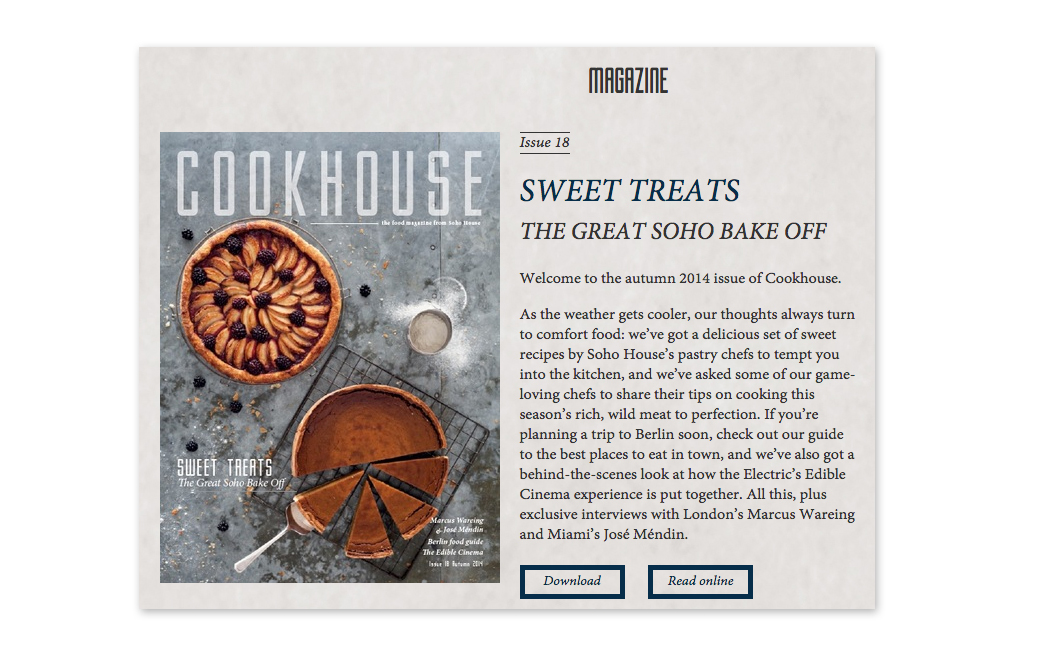
Magazine App
I describe app store newsstands and app magazine formats below from a publishing industry participant perspective, however almost all magazines that are not print or digital edition label identified are marketed by publishers as their digital magazine or digital edition to avoid confusion related to technical aspects of the app delivery process.
APP STORE NEWSSTAND MAGAZINE – Apple iTunes App Store Newsstand or Google Play Store Newsstand platform based digital magazine edition with sequenced views or pages of issue content and platform based issue navigation and app based utility features.
The Apple iTunes App (iOS device platform) and Google Play Store (Android device platform) Newsstand respective apps represent a single newsstand app that operates as a digital bookshelf for the publishers utilizing this core periodical delivery system specific to the mobile OS (operating system) platform. This master newsstand app allows in app purchases for additional paid issues distribution as well as provides the presentation user interface (UI) and issue notifications. Like all other app purchases specific to each of these two main app store newsstands, Apple and Google receive a percentage of all subscriptions or per issue payments purchased via the app store.
Video: Magazine App and Newsstand Based Publications Distinction
Apple App and Google Play Store Newsstand portals provide access to the series of issues based on the user’s tablet or smartphone OS. There is only one master app store specific newsstand on each of these two leading app store platforms and authorized developers may display the store logo adjacent to their magazine app name.
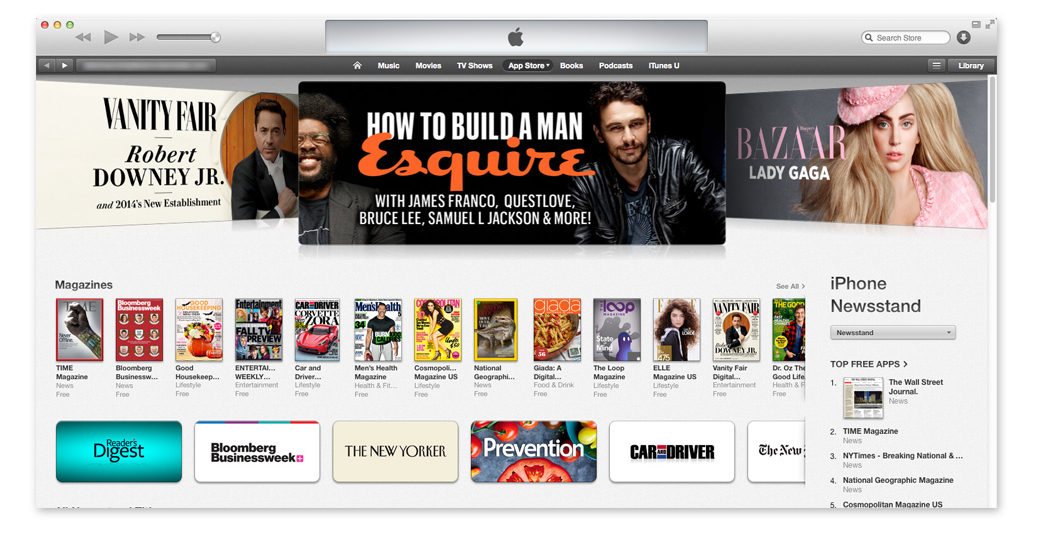
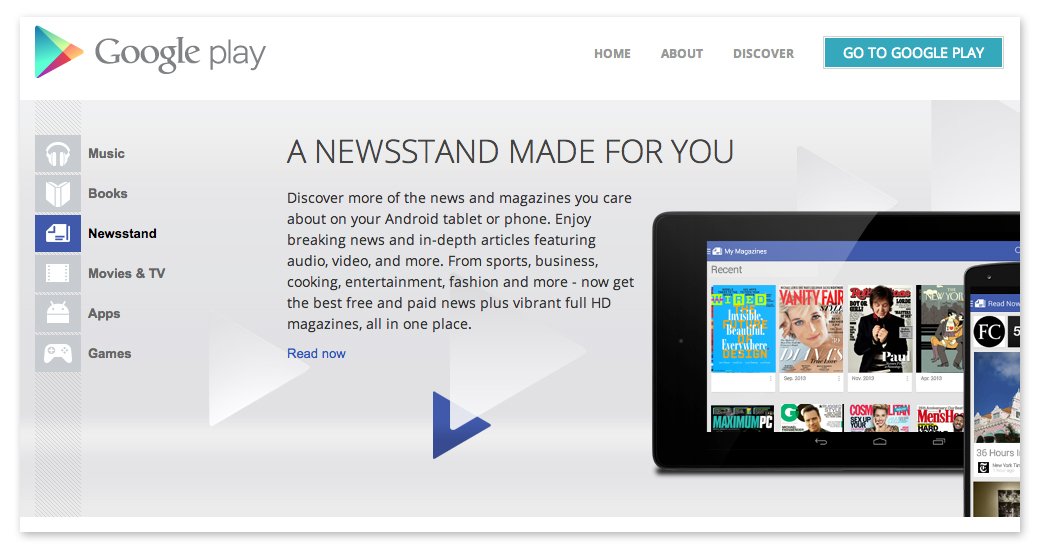
In addition to the official Apple or Google Play Store logo the magazine app would also have a uniquely designed icon for each platform with the magazine name and/or style branding.
Example: Bello Mag and Apple App Store Delivery Platform Identification
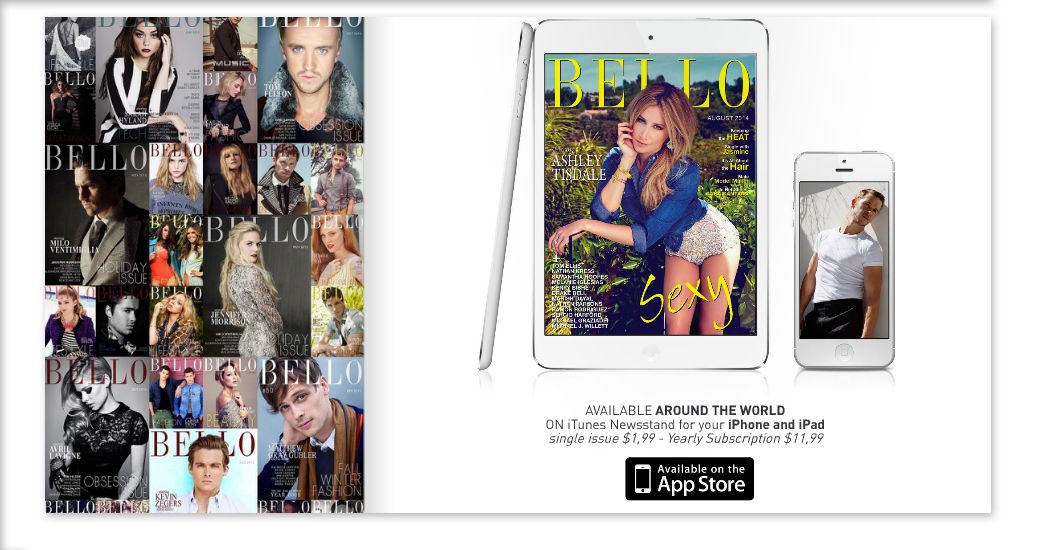
As cited in the video above and in addition to the key app store platform based newsstand magazine issues management app, many publishers have also created their own magazine name titled app such as The Atlantic or use a 3rd party platform app such as Issuu and Zinio to access archives and current issues for a specific magazine. When branded to a single magazine title (ie. The Atlantic), these apps provide access to current and archive issues. And when functioning as a multiple publication newsstand app (Zinio) provide this same issue access to any of the magazines that have be formatted or produced for that specific newsstand app.
MAGAZINE APP – An issue management application providing digital magazine edition access compiled within a custom app, app store newsstand, or 3rd party newsstand app installable to the user reader device.
Most apps present content in a digital edition format typically distributed on both Google Play and Apple’s app store where the magazine app version selected by the consumer depends on the Android or iOS operating system of the reader’s hardware phone, phablet, tablet, or other mobile OS device.
The official app store branding button is displayed to identify the app store platform linking to the specific magazine app for download. These apps would have their own separate app store app as a single or series editions. While the Android, iOS, and Amazon mobile app stores maintain the majority of mobile app distribution (which do not work on PC operating system platforms) there will ultimately be other app distribution channels such as Google’s Chrome Web Store which offers desktop browser users a rapidly growing list of apps and extensions.

The magazine app as a tool to access and read issues should not be confused with a brand extension magazine utility apps. For example, a camping adventures magazine could have both an issue access “Camping Magazine App” and a utility “Campsite Finder App.” A publisher might have several apps for both cross platform issue access and even more apps for specific utility, social interaction, or other brand extension function or revenue objective.

Today, uniquely branding a utility app to a specific purpose is a more effective strategy than aggregating multiple value offerings as an all-in-one app within an existing magazine app where issue access is the consumer core usability expectation. It’s not that these elements aren’t valuable in the app, but the UX cluttered with many channels and utilities is better achieved using the website as the master brand extension utility hub. App platforms typically provide a limited description and marketing capabilities and if distinguished utility value exists for the app then it warrants marketing the app as a separate deliverable for the magazine brand.
3RD PARTY MAGAZINE APP – ie. “Zinio Edition or Zinio App Edition” – Platform app newsstands provide multiple issue based delivery in a similar format to the core app store newsstand. Users are required to install the Android or iOS based 3rd party branded app to read magazines available through the issue catalog and viewer app. Most publishers utilizing an app based production and newsstand platform promote their app magazine issues as their digital magazine, digital edition, or under their own brand as their iPad, iPhone, mobile, or tablet edition. 3rd party digital publishing partners typically don’t white label the process and the access app branding are visible to end users and the 3rd party app developer has ultimate control over the newsstand app. Publishers describe the process of downloading the third party reader app for users who wish to view their magazine app edition. The positive side of this model is lower cost and simple production process. The downside is that they publication is not exclusive to the vendor app and thus readers can easily get sidetracked with other publications promoted to any users utilizing the app to view magazine newsstand issues promoted to every user of the 3rd party app. Some vendors do offer the ability to create an exclusive stand alone app based on the technology platform foundation for an additional fee and the publisher would submit the produced app as their own proprietary magazine app.

ONLINE MAGAZINE – The online magazine is a digital magazine and defined with a word that places less emphasis on multimedia or other digital user experience enhancements beyond editorial formatting for the digital (online) presentation. While “Digital Magazine” has been used more prominently among professionals within the publishing industry, and in the early 2000’s this label would differentiate from the many less structured online magazine (e-zine) website startups, the term online magazine has evolved to become a branding term of choice for many digital magazine publishers. Using online magazine maintains the expectation that the publication is available online and implies that there is no print magazine edition. The term online magazine also reduces emphasis for the higher expectation of interactive or technical elements that are often used to accent features of modern digital magazines.
“Digital Magazines” of today will become the default “Magazines” of tomorrow
My definition of the “digital magazine” or “online magazine” utilize the “digital” and “online” as transition terminology. We will not need to precede the word “magazine” with “digital” or “online” in the next decade. The digital format will become the standard delivery format and structure for profitable mainstream business and consumer magazines. Thus, a digital magazine will be referred to simply as a “magazine” in the same way “ebooks” or “digital books” will once again only need to be reference as “books” by default with digital becoming the format expectation within the next generation. Terminology such as “Online” implies a status or activity where the user is connected or networked “online” which has less relevance in a modern era when we are always online everywhere.
In the near future era, it will become necessary to address the characteristic of being printed on paper “the print edition” as the exception or novelty edition when compared to new modern digital magazine equivalent. Reading periodic content from paper will not be the default medium for future generations. Publishers that offer this format will treat it as a premium format and highlight this as unique traditional delivery format. The label for these magazine editions will need to include the word print as “print magazine” or “print edition” to highlight this format as unique to the expected digital format publication. Thus the print format, will becomes the inverse reference to the way we add “digital” as the delivery format descriptor today. I’m certain print industry proponents will disagree with my futurist view and I certainly understand the value of a print magazine readily available for convenient access on desk as opposed to an easily missed issue access notification or email with the link to the latest digital magazine issue. However, digital media delivery will be the majority and default format for published media in the very near future and that and the future of the fax machine can’t be changed.
Another feature of the modern digital magazine will be the challenge to the permanence or editorially completed nature of today’s print magazine definition. As new media takes on a living, ongoing, collaborative format aided by commenting, discussion, debate, and editor/publisher moderation directly at the published source as well as externally via offsite social platform and stream discussions we will develop an elevated and refined version of the original published content. And when properly cultivated, the content will become perpetual both edited for improvement and enhanced collectively inline with comments and annotations that give greater value to the work and allow the most recent reading audiences to gain the greatest knowledge and value from reading the enhanced published work. (see also https://advontemedia.com/getinspired/publisher-website-comments/) Core article content changes will be referenced in visible history & changes format for editorial integrity, but the evolved content may even contain added or completely adjusted key journalism elements.
Magazine Websites
MAGAZINE WEBSITE – Website representing a magazine brand utilized as the brand central hub to engage and build audience for the defined topic/interest niche with access to multiple content channels and brand extensions as well as core brand magazine issues and subscription process.
The magazine website is typically optimized for content relative to a core topic, activity, industry, location, or similar interest niche. Most websites representing a named magazine brand promote or facilitate the access to the print magazine, digital edition, or digital magazine. The magazine brand website will function as the central hub for the entire magazine and it’s various brand extensions and content channels. The website can also sustain strong ongoing audience interaction for web content published in between the periodic publishing model of the issues based magazine. Daily and weekly newsletters, news, blog, events, live media, resources, guides, community, photos, and other original, curated, and audience submitted content items can be published that might extend issue based content or be published in a web only editorial workflow to include promotion of content for social media and search optimization. The website is becoming the primary 24/7 subscriber and newsletter acquisition channel. The publisher’s website has large growth potential revenue generating capabilities from content access models, registrations, events, webinars, training, display advertising, and other resource and exposure based advertising packages. The website is a critical and primary component for any modern magazine brand and many magazine content management system (CMS) platforms will also soon become the foundation for organizing issue based content for the publisher’s digital magazines.
Outside magazine’s website provides much more than periodic magazine issue access. It’s the always active audience destination for content and provides advertisers a many additional ad and sponsor opportunities. The brand has even launched a video based tv channel.
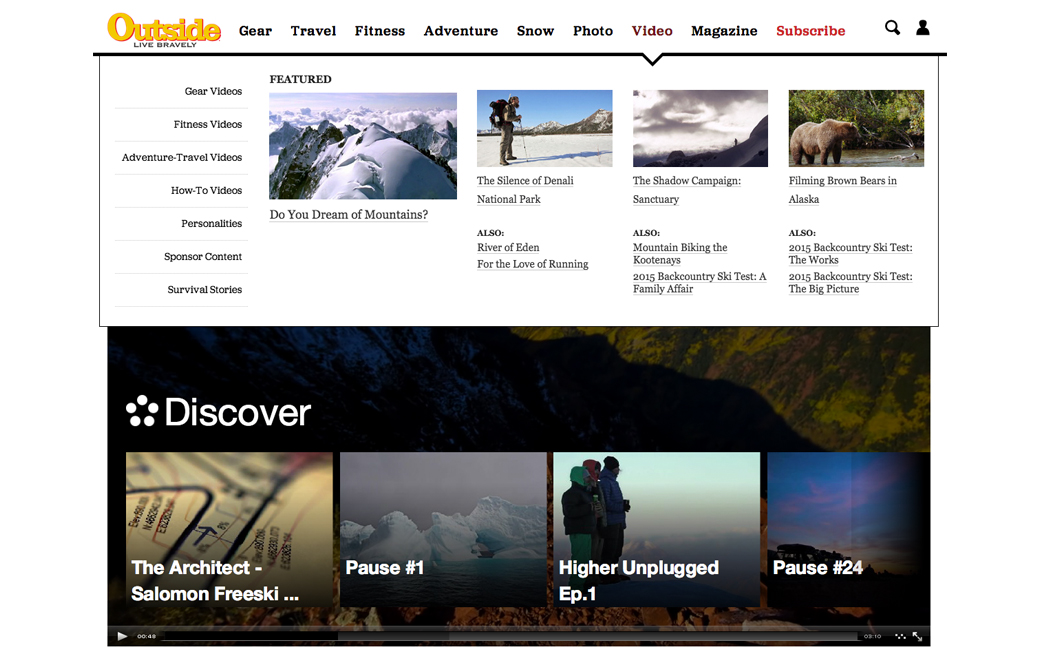
The next few years will be critical for digital transformation of traditionally print focus brand offerings. However, there will continue to exist a significant percentage of publishers that fail to innovate their publishing model by placing equal importance on the website and digital elements of the brand during this rapid growth period. The relevant audiences for long term growth capable magazine brands will utilize digital devices and require multi-channel media access options anchored from the magazine website.
Some websites that contain “Magazine” as a metaphor but have no formal periodic or issue based content organization are more consistent with (and should be labeled) a general interest website and not a magazine. The word magazine does not add value to this website only format when magazine business model elements are not present to help align the publisher brand purpose or expectations of audience and advertisers. This is not to say that these sites are not valuable. They can typically perform many similar functions consistent with the magazine publisher’s audience value model. General and niche interest websites are considerable competitors to the digital magazine publishing business model and are growing much faster than magazine branded based media. Eventually, these sites will dwarf magazine name brands. However, my definition for the modern and next generation print or digital magazine differentiates from a pure web only niche brand by observing the full periodic editorial assembly of unique and valuable content elements demonstrating both journalistic talent, original content over aggregation and reporting, and design creativity for the periodic magazine format deliverable. A magazine instills this high expectation for quality and style.
Additional Magazine Brand Format Descriptions
ONLINE MAGAZINE WEBSITE – A website publishing edited original and curated/aggregated content on a periodic basis to provide an organization or archive of issue based content. The content presentation is typically centric to the web publishing system and not a custom layout and design. However, the feature and article content elements may contain a unique design elevating the content value.
A stand alone website simply titled to include the word magazine, but lacking any significant relevance to expected or traditional magazine publishing model elements would simply be a general or special interest niche website and not a magazine. During the early Internet circa 2004, many initial world wide web interest niche style websites were established and branded as “online magazines” or “e-zines.” The growth of branded blogs replaced the popular use of zine and online magazine as terms to represent the topic or niche beat covered by the author.
TABLET EDITION / TABLET MAGAZINE – Tablet based magazines or editions are Magazine Apps. A tablet is typically 7 to 11 inch display mobile wifi or mobile broadband service device and the layout structure of OS for Apple iPad, iPad Mini, and Android OS tablets is the best form factor to replicate the portrait print magazine single page or in landscape mode a 2 page spread layout presentation structure. Some apps are available in both smartphone and tablet form factor and other are limited to the tablet. Just wait, soon you’ll be able to read your magazine on your watch although I hope to see small wearable tech form factors simply provide notification that your issue is available when you are able to really enjoy the content and reading experience using a tablet in the same way you once cozied up with a print magazine.
E-MAGAZINE – Derived from Electronic Magazine during the early Internet era, the e-magazine label has been used to represent everything from custom digital magazines to downloadable (typically PDF format), offline, mobile, epub, html5 and ebook/e-reader format. Today there exists many digital publishing software and cloud based solutions to convert magazine PDF’s to a more readable and cross-platform friendly “digital magazine” or “online magazine” CMS based formats defined above.
The organized, edited, and designed digital magazine format compared to simple curation or aggregated content provides a significantly greater reader experience and elevates the magazine media type definition. Yes, long live the magazine!
![]()
Strategy & Design for Magazine Publishers
Learn how Advontemedia helps to plan, design & upgrade publisher websites
Advontemedia Magazine Publishing Consultants
Media Definitions Reference:
Magazine.org provides a section of articles related to Digital Magazines
Publishing Executive Magazine e-media coverage
Folio Magazine digital editions coverage
2016 DIGITAL PUBLISHING PLATFORM SERVICE ANNOUNCED – Modern Magazine Web Editions


